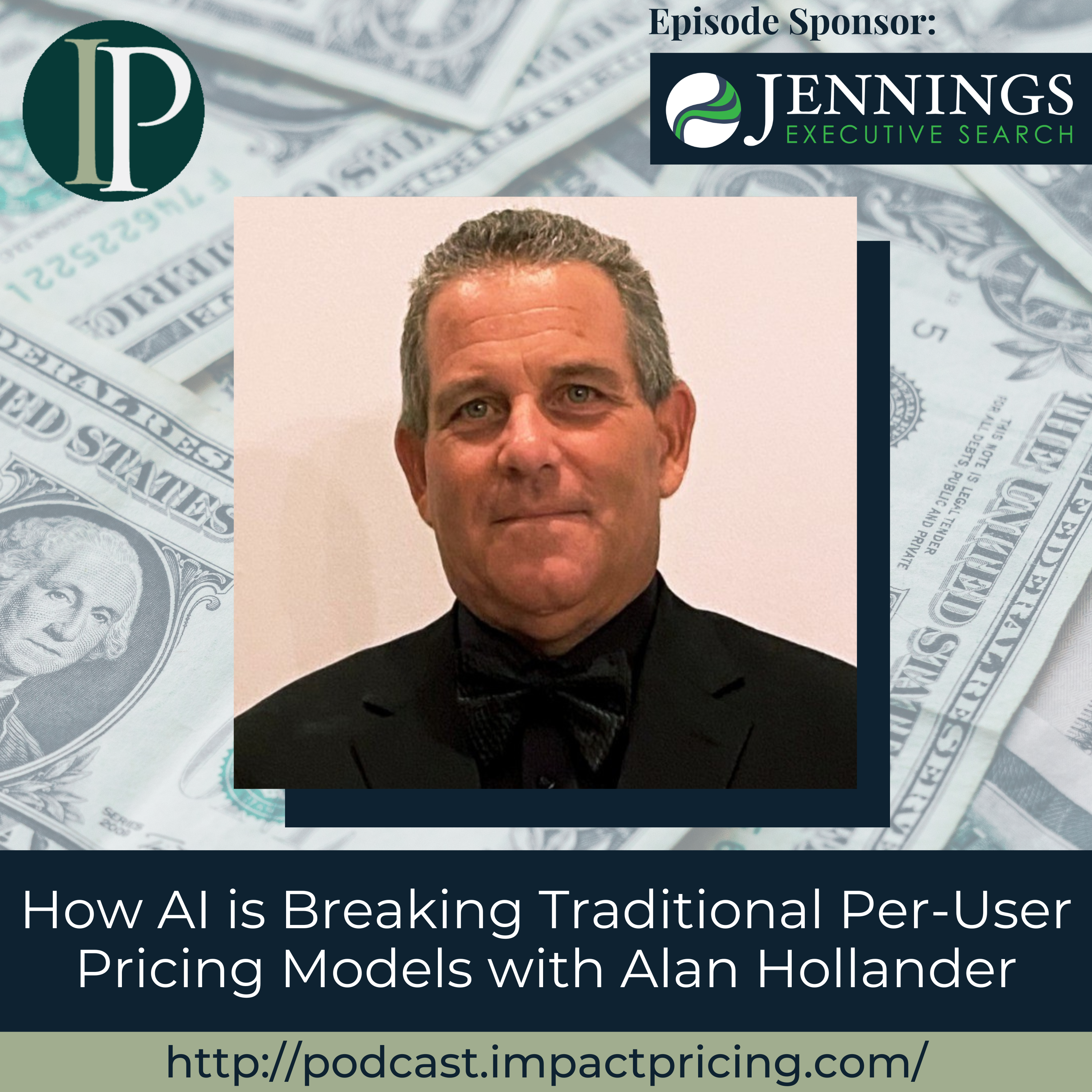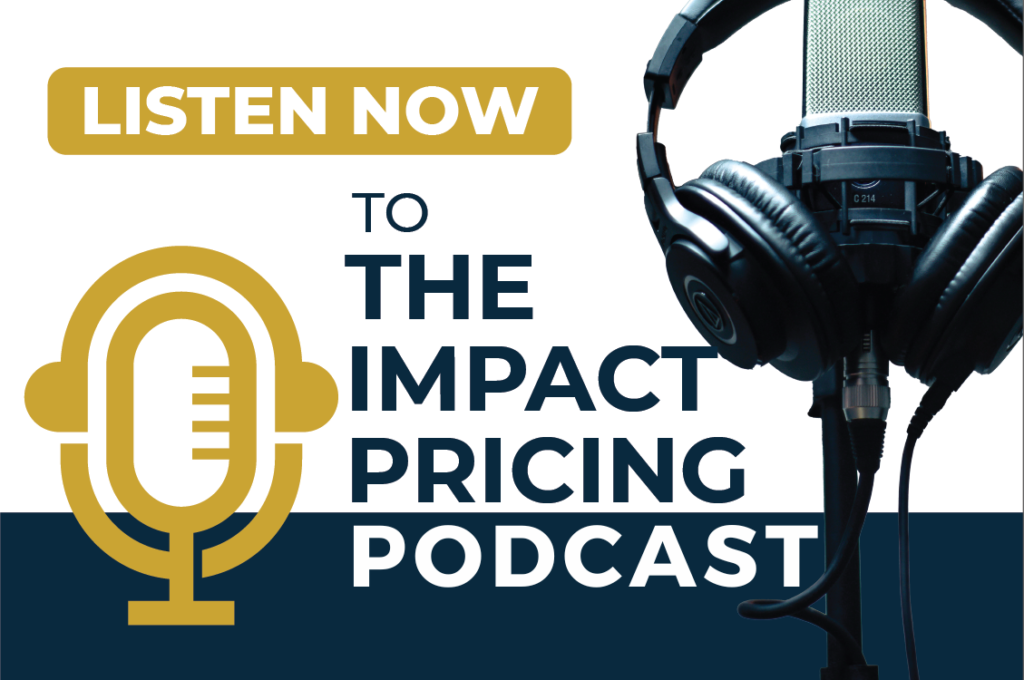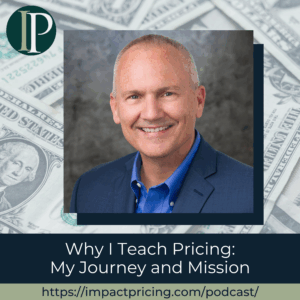
In this episode, Alan addresses a major challenge for SaaS companies: how AI disrupts traditional per-user pricing. Drawing on his experience at Blackbaud (serving nonprofits with CRM and financial tools), he explains why AI’s efficiency conflicts with seat-based pricing. He and Mark discuss the difficulties of shifting customers to new pricing models, managing multiple approaches, and implementing pricing innovations gradually.
Podcast: Play in new window | Download
Why you have to check out today’s podcast:
- Understand why AI is fundamentally incompatible with per-user pricing and what alternatives actually work in practice.
- Learn how to implement pricing model changes without overwhelming your organization’s operational capabilities.
- Discover the “crawl, walk, run” approach to pricing transformation that builds momentum through proven results.
“Don’t go right to the end goal, in the future state, because people are just going to look at you cross-eyed. Start with quick wins, start with test pilots, test the concepts, show the results, quantify the results so you can build momentum in launching new pricing models.”
– Alan Hollander
Topics Covered:
01:30 — Alan’s pricing journey: From Tom Nagle’s student to Strategic Pricing Group veteran
02:45 — The AI pricing dilemma: Pricing products with AI vs. using AI for pricing
04:15 — Why AI pricing isn’t different: It’s still all about jobs-to-be-done and value creation
11:15 — The nonprofit sector challenge: Selling efficiency when budgets are already tight
14:30 — Human augmentation vs. job replacement: Reframing the AI conversation
16:45 — The Salesforce problem: When AI doubles productivity but revenue stays flat
19:20 — Blackbaud’s approach: Combining user-based and consumption-based models
21:45 — Market segmentation reality: Financial vs. fundraising as separate buying centers
24:10 — The PayPal model: Why percentage-of-success pricing works for fundraising
26:30 — Optional pricing models: Letting customers choose fixed vs. variable approaches
28:45 — The operational reality check: Systems and processes needed for pricing flexibility
31:00 — The “crawl, walk, run” philosophy: Building momentum through incremental wins
Key Takeaways:
“Per user is not going to be the answer. You’re going to stagnate because unless you’re just going to increase your per user price, it doesn’t align with how they consume, how they use, what value they get.” — Alan Hollander
“Sometimes you have to do the right things before you do things right… you can have a beautiful strategy in terms of how you monetize and price, and it’s very elegant and you’ve done all the analytics and it looks super cool. But sometimes you actually need to basically what I would say, do a crawl, walk, run.” — Alan Hollander
“If you don’t lead with the value, I don’t care if it’s AI, SaaS, it doesn’t matter what it is. If you don’t lead with the value in a business case… you’re not going to get anywhere.” — Alan Hollander
Resources and People Mentioned:
- Blackbaud: https://www.blackbaud.com/
- Tom Nagle: https://www.linkedin.com/in/thomas-tom-nagle
- Reed Holden: https://www.linkedin.com/in/reed-holden-913ab69/
Connect with Alan Hollander:
- LinkedIn: https://www.linkedin.com/in/alan-hollander-753167/
- Email: [email protected]
Connect with Mark Stiving:
- LinkedIn: https://www.linkedin.com/in/stiving/
- Email: [email protected]
Full Interview Transcript
(Note: This transcript was created with an AI transcription service. Please forgive any transcription or grammatical errors. We probably sounded better in real life.)
Alan Hollander
Don’t go right to the end goal, in the future state, because people are just going to look at you cross-eyed. Start with quick wins, start with test pilots, test the concepts, show the results, quantify the results so you can build momentum in launching new pricing models.
[Intro / Ad]
Mark Stiving
Welcome to Impact Pricing, the podcast where we discuss pricing, value, and the nuanced relationship between them. I’m Mark Stiving, and I run boot camps to help companies get paid more. Our guest today is Alan Hollander. Here are three things you want to know about Alan before we start.
He is the VP of Offer Packaging and Pricing Strategy at BlackBaud. He’s been doing that for six years now. He was the head of Market Offers and Pricing at Ellucian. He did some time with Simon Kuchar. But here’s my favorite thing. In 1994, he was hired into Strategic Pricing Group by Tom Nagel. Welcome, Alan.
Alan Hollander
Thank you. That probably gates me in terms of how old I am, but that was my first foray into pricing. Just a little known fact, actually Tom was my professor in business school and I took his course, the strategy and tactics of pricing. I did very well in it, got an A. I absolutely loved the topic and it was, that’s, so that’s where things started. And I worked with Tom and Reed Holden for about six years and I never looked back.
Mark Stiving
I tell you what, I like both of those guys a lot. I had never met Nagel, I always wanted to, and then about a year ago, he agreed to be on my podcast, which was nice. And then I got to meet him at the following PPS. Really nice guy, super smart. So it was fun, and I’ve known Reed for a long time. So two really smart guys.
Well, let’s talk about the elephant in the room nowadays. And that is AI and price. We talked for like 10 seconds before I hit record. And what we realized is that neither of us knows what the heck’s going on. So let’s see if we can figure some things out and see if we can make any sense of it.
First off, let me toss out the big softball. Are you focused more on how do you price products that have AI or are you focused more on how do you use AI to do pricing?
Alan Hollander
The former right now, right now we’re focused on how we monetize AI in the marketplace right now.
Mark Stiving
Okay.
Alan Hollander
I’ll just say it’s interesting because we as a company have done a lot of internal testing pilots in terms of how we can use AI to be more operationally efficient. So we’ve done a lot of that. I have not used it yet within pricing. That is probably on our plan for next year. So most of my focus is how do we monetize that within our portfolio externally with customers and products.
Mark Stiving
And there are people out there trying to figure out how to use AI to do pricing right now. And so I’m sure that you can go buy that eventually, right, if you need to. So let’s focus on how do we price AI products or products that have AI in them? Why is it any different? We were watching the webinar that I did with Michael and Stephen, and that question actually came up. And I’ll tell you, my answer is there’s no difference whatsoever, right? My answer was, it’s all about value. So go ahead. Tell me how this is wrong.
Alan Hollander
I don’t think it’s wrong. I think Steven brings up a good point and I don’t think people necessarily appreciate it, but you really have to really drill down into the jobs to be done. So what sort of use cases is AI going to solve in terms of specific tasks, workloads, processes that is going to make life faster, easier, better. for that organization and specific users in that organization.
So I don’t think it’s any different. I think it’s just, it’s another layer of detail you have to get into because a lot of it is educating customers and prospects on like, Hey, how am I going to use it? I don’t know who’s going to use it, where I’m going to use it. Like, just help me understand it, like move beyond the technology and the speeds and feeds and functionality.
How is it going to help me either acquire more customers, retain more customers, become more operationally efficient right and you have to be able to explain that within the context of look. AI and this is where it gets sensitive right i think this is the only nuance where a lot of the i think trepidation is with. Hey, okay, I’m going to lose my job. And a lot of what we try to look at is like, this is not about losing jobs, right? It’s about human augmentation.
So if I’m already overwhelmed, right? And I, I’ve got to do more with the same or less, how do I leverage AI to be more productive, more efficient, and focus on high value, high impact, whether it’s initiatives, efforts, and solve the ones that are like lower value or lower impact in nature.
Mark Stiving
Okay. So I don’t think we disagreed at all in the sense that I said, look, it’s all about value. And you said, yeah, we have to understand what job to be done. And we started talking about, am I going to win more business? Am I going to keep my current customers? So these are really important concepts that are all value driven.
Alan Hollander
Yeah, exactly.
Mark Stiving
And so if I were, and I think about this all the time, if I were trying to figure out why is AI really throwing a monkey wrench in things? I think the problem has a lot to do with what you just said at the end of that. And that is, it isn’t that we’re getting people to lose jobs. It’s that we’re making people more efficient. We’re making people more effective. And most companies, most SaaS companies have charged per user.
And so if we keep charging per user and we make people more efficient, we make less money. And that’s a problem for us as a provider, as a seller. The customer loves it. But what we want to do is we have to start rethinking those pricing metrics. What are we charging for? So we can’t charge per seat if we’re going to make people more efficient. I’m tossing that one to you.
Alan Hollander
Yeah. I mean, look, I’m sure you studied it. Everybody probably out there has studied this. I mean, I’m going to generalize, but there’s only so many models you can look at, right? One is a user-based model. One is some sort of usage or consumption-based model. One is a hybrid of the two. And the other one is pure outcome, right?
Those are the ones that at least we internally conceptualize. I think to your point, you know, there’s a lot of back and forth about, is it per user? Is it usage? Is it a combo? You know, there’s not one right answer. I think to your point, as you start to do augmentation, like I’ll give you an example, just very quick. So BlackBaud is actually, we’re basically a CRM for the nonprofit industry that includes K-12, higher ed, arts and cultural nonprofit, things of that nature, right?
And we also have financial backend reporting and management tools as well. So quick scenario, right? Budgets are very tight in that industry. And the point of the matter is like, if I want to augment somebody, like we’re basically augmenting hiring additional staff, right? Cause there’s only so much you can do at the end of the day. If you think about it, I can’t necessarily go to some of these companies and say, Hey, I know your budget’s limited.
You’re probably paying somebody very low on the salary scale. Pay us another $50,000 to $70,000 because that’s basically the price of a headcount, right? It becomes very difficult when you, it’s a tricky conversation to have when you frame it on a per user basis, particularly in certain industries, even though you’re selling the ROI. And to your point, if you’re augmenting, you can try to go down that path.
But at the end of the day, it’s easier said than done, I guess. And I agree with you on the per user. I’m just giving you some nuances that we’re encountering when you try to go down that path.
Mark Stiving
Yeah, I think that’s a really interesting problem that says. How do I convince someone that you’re gonna lay someone off? Especially in the nonprofit world, they’re not focused on how do I make more money, they’re really focused on how do I serve a community?
How do I serve whatever my social good is? And oftentimes they think in terms of, and I apologize if I’m wrong, but they think in terms of how big of an empire have I built? We really see this in government.
Alan Hollander
Yeah, I mean, I would probably disagree because I’m on the board of a nonprofit. I mean, they’re in business to…they’ve got to make money. They’ve got to drive revenue. Because at the end of the day, that surplus is used to reinvest in new programs, potential headcount. So even though they’re called nonprofits, they’re 5013Cs, they still have to file with the IRS.
So they do have to have a surplus to some degree, and they do need to make money because at the end of the day, it’s all about how do I grow and invest? Because you’re right, the overall mission of these nonprofits is to try to serve as much of the community and make a difference in the community, whether it’s fee for service, whatever it is, right? They’re trying to grow and basically connect with more of the community.
But in order to do that, they need to have the funding to launch new programs, to increase headcount, to invest in, could be some sort of equipment, facilities, things of that nature. So it is for profit. The issue that we run into is, though, I’ll just make it up. If you need to add a campaign manager, because you need to do fundraising campaigns, or an operations manager because you need to coordinate volunteer staff.
You’re talking, I mean, those are additional headcount, right? And generally speaking, at least the one I deal with is a cash business. So if you don’t have the cash coming in, you can’t fund those investments, right? So at the end of the day, what AI does is it says, hey, look, forget about trying to hire these two headcount that you kind of don’t have the budget for, we’ll do it for you, right?
The question is, what’s the ability and willingness to pay, like in my vertical, given that you’re talking about relatively large headcount numbers, right, but you have a limited budget?
Mark Stiving
Yes. And I think that comes down to the problem, right? So if I put myself in the shoes of the buyer here, they would be willing to pay, let’s just call it $50,000 for a headcount if they had the budget. because it provides that much value to them, but they don’t have the budget.
And so the really nice thing about AI and software in general is that we have the ability to do a partial implementation, right? So we could sell you $5,000 worth of a person, and then as you grow, as it becomes more effective, more efficient, you can get the budget, we can move that up to 50K.
Alan Hollander
Right. And to your point, I think the important point you’re making is that’s why per user kind of gets problematic because you’re basically trying to say, hey, it’s per user per month, whatever. But that doesn’t necessarily help scale. Right. I mean, at some point and again, feel free to disagree, Mark, but.
What I get out of your statement is, what you’re saying is like, we can scale the price based on either how much you use or consume, or what the outcome is, right? Not kind of like a flat per user per month model, but we’ll scale it based on some sort of metric, whether it’s consumption or outcome. I think that’s implied in what you’re saying, but feel free to disagree.
Mark Stiving
No, that’s right. I think the biggest problem with AI is that too many companies have charged per user in the past, and AI almost demand that you can’t do that. And the one exception I would use is co-pilots, right? If you think about co-pilots, they fit perfectly with, I’m gonna charge per user because I’m already charging per user for office. Why wouldn’t I charge it for the AI accessory to it?
And so that fits well, but besides that, it feels like everything we do in AI is how do I make people more efficient? How do I get more people out of the middle of the process? And so therefore we have to come up with new pricing metrics. And companies just don’t, I don’t think companies sit back and say, what’s the right pricing metric? What are the exercises I should go through to figure out what’s the right pricing metric?
Alan Hollander
Yeah. And I, I think this is where I struggle with this one, right? Because people look at say Microsoft or Salesforce or other companies. that their bespoke model is per user. Right. And I say, well, they’re doing per user, but you have to step back and say, yeah, but they started with per user. So what they’re basically doing is saying, Hey, I’m not going to muck up the works.
I want to make it easy because my customers are used to per user. I’m just going to do a per user add on. It’s simple. They get it. That’s how they’re already paying. Right. Now, there are some folks that are now starting to experiment. I’m seeing Salesforce starting to experiment with per user and then your usage credits and combinations. And so the question just becomes how disruptive is that, right? You can say, Hey, I really want to go in this direction.
The question that we struggle with, and I think everybody needs to think about is how disruptive is that in your marketplace? In terms of how your customers will understand how to buy and pay for those capabilities, right? And that’s the thing that, I mean, there’s a lot of great models out there. They’re very innovative, but ultimately if your customers are getting confused, they don’t know what they’re paying for.
They don’t understand how it tracks with some sort of process, workflow, use case or value. It can be confusing very quickly. So I think that’s the big challenge for everyone is there’s a lot of different ways to innovate and do it. But if your customers are set on a certain way of buying from you and they have been conditioned to do that over time, how much discontinuity does that introduce and how much work does that require from you to reeducate them?
Mark Stiving
Yes. And it’s suddenly hitting me the power of the fact that I’m going to replace people. And so how do I convince someone to either fire someone or, you know, replace them with attrition or, you know, move them to another role where they could be more effective and do something else. And, and that’s just a really challenging sale, no matter what situation you’re in.
Alan Hollander
No, I agree. And I think that. They immediately, and again, part of it is if you just get on the internet and start reading, I mean, everything’s about looking at kind of what jobs are being replaced, what jobs are going to become obsolete. And it’s a very difficult kind of perception to get around. And that’s why we continue to kind of focus on human augmentation, because it’s basically trying to do more with the same or do more with less, right?
Again, there’s a certain amount of workload, everybody’s continuing to say that they’re being overworked, they’re stressed out. So how do you use AI as your companion, right, your helper, right, to have you do more with the same or less, right? And also, how do you grow without having to have a commensurate Investment in additional headcount and the only really way to do that is really through a unless you’re gonna maybe outsource somewhere but.
We got a pivot towards that as opposed to my god i’m gonna lose my job well how about no you’re not gonna lose your job. your job may actually get re-architected so that you can actually focus on more strategic, higher-value initiatives in your company, right? You can re-architect your job and not do some of the things that might be more mundane or menial, right, in nature. But that’s not an easy thing to convince people of.
Mark Stiving
And the type of people who take the mundane or menial jobs usually aren’t the type of people who are crafting a new strategic role for themselves.
Alan Hollander
Right. Exactly.
Mark Stiving
So it’s really interesting. Let’s talk about Salesforce for a second. And by the way, I’m not a Salesforce expert, so I’m going to pretend that I know what I’m talking about. Please know that I don’t.
Alan Hollander
Neither do I. I know enough to be dangerous, Mark.
Mark Stiving
but Salesforce charges per, let’s just say per salesperson, right? And so we come up with AI and I can now make it so that a salesperson can sell twice as much than they used to sell. And so what we just did was we just said, hey, a customer of ours can grow double the size and we get no incremental revenue. That’s a problem.
Alan Hollander
I agree. I mean, I, so this is where you and I are a hundred percent in alignment. I think in the SAS world these days per user, I mean, if you want to use it to maybe drive adoption, I mean, maybe that’s what you do. But if you think about everything we talk about in terms of aligning your pricing metrics and units of measure to the customer’s business and trying to align it to how they grow, right? Per user is not going to be the answer.
You’re going to get stagnated because unless you’re just going to increase your per user price, it doesn’t align with how they consume, how they use, what value they get. I mean, people out there could argue with me, well, Alan, that’s not necessarily true. Because you know blah blah blah i have this product line and there’s only a certain amount of users for it but i don’t know what the growth lever is for per user other than adding per users or maybe having different sometimes you have you only users you have power users like you can segment that way.
But i think it’s much more limited to be honest with you to your point from a growth perspective when it comes to pricing it’s very limiting and again to your point about cost reductions you know some of these things basically you’re saying well i’m not going to need maybe to add as many people for this particular task as i thought so there’s a limitation in terms of per user growth as well. I think it’s it’s challenging. I know there are certain kind of use cases where it makes sense. I just think they’re very few and far between these days.
Mark Stiving
And so without asking you about your company, unless you want to talk about it, you guys are essentially in this exact same situation. Right. Where I’ve got, I’m making people more efficient, more effective at the roles. And so they don’t need to hire as many.
They don’t need to, you know, they could get rid of some or replace some or reallocate some. How do you change your pricing model then? How do you go back and say, what are we really going to charge for?
Alan Hollander
Yeah. I mean, what it’s interesting. I mean, we have different. We actually have a couple of different models. There is one product we have per user. We have basically looked at adding another attribute to it. So this is where we’re trying to say, okay, look, per user is somewhat limited. We’ve added a second attribute to it, which is based on kind of customer size. So revenue. So we’ve evolved that.
We have another metric that’s more what I would call consumption based. So, I mean, I’m not going to, anybody can look it up, but it’s very similar to kind of, if you look at HubSpot, it’s, you know, for our fundraising product, it’s the number of contacts in the database. So we have different models.
What we try to look at is, and we’re in the middle of this too, is we’re trying to say, okay, how much overlap is there in terms of the use case or the value that somebody gets using, say, our financial product versus our fundraising product? Because if you think about it, for us, you kind of got to step back and say, okay, who’s purchasing this? Are there two different departments? Is it at a corporate level?
And basically how much commonality is in terms of how they use it and the value they get out of it. So we’re trying to align based on that. It’s not the easiest thing in the world. The other thing which people don’t think about and not everybody has a luxury to, to be able to just move ahead with is how integrated are those products, right? Because if you’ve got a number of different point solutions and they’re not fully integrated.
That can also kind of limit how you, I would say, harmonize the pricing models, right? So we are going there. We’re trying to put some tweaks on the per user model, but eventually the key is going to be how well we integrate all of our products into kind of a more of a seamless portfolio. They’re close, but we’ve got work to do.
Mark Stiving
Yeah. So I like to think of what you just described as two different market segments, right? So one market segment’s the financial side, another market segment is the fundraising side. Even if it’s the same company that wants both or uses both, if I think of that as two different market segments, then when someone loves one of my products, then they tend to trust us and like us and they’ll move into another one of our products, right? This is like LinkedIn recruiter and sales navigator, right?
Alan Hollander
No, you’re, you’re right. And again, for us, we’re trying to get there. I think the other thing that you also, again, not with going into the weeds on this, but you know, you also got to look at who holds the different budgets and some of the things that, and again, I think people out there will understand this is you can have an integrated solution like Salesforce and you can have, you know, the marketing element, the sales element.
There’s a data element like customer success and all that stuff. The issue is when it’s not just for us but others out there like are those budget decentralized or centralized. And if you’re trying to sell across right if you think about the realities of it. You’re now having to actually deal with two different kind of people that are controlling the budget if not more. Right. And the other thing that I think everybody would acknowledge is a longer sales cycle.
So depending upon your business, right, if you’re a high volume transactional business, you got a lower ASP, that’s not going to be something you want to spend the extra time on. If you’re a larger enterprise business and that’s kind of, you know, your sales cycles are longer and maybe that’s not such a big deal, but to me, that’s the conundrum that you face. Like I’ll make it up.
Do I want a higher volume of $20,000 ARR deals because I’m just going to sell to this one department or do I want fewer deals at $100,000 but they’re going to take me six months to a year as opposed to the 20,000 ones that are going to take me less than three months. So that’s, I know we’re going beyond pricing, but the reality is that influences, right? How you sell and then how you price and you can simplify your pricing as much as possible.
This is my big thing that I always say internally. I can give you whatever pricing you want in terms of cool metric. I can simplify the pricing, but if we are still hitting roadblocks in terms of the number of different departments and budgets we have to deal with. and there are differences in people’s willingness to pay. It’s just going to slow things down. It goes back to where you started, Mark.
If you don’t lead with the value, I don’t care if it’s AI, SaaS, it doesn’t matter what it is. If you don’t lead with the value in a business case that says, hey, here’s how I’m going to solve your problem in fundraising, the fundraising department, and how I can solve it within finance, and you don’t lead with that out of the gate, you’re not going to get anywhere.
Mark Stiving
Yep. No, I agree completely. So My favorite pricing metric of all is PayPal. So PayPal takes 2% of the revenue and I cannot wait till I owe PayPal a million dollars. Right. Cause that means I made $50 million and that’s okay. Right. Doesn’t bother me in the least. So I could imagine in your world, that’s a great metric for fundraising.
Alan Hollander
So, so we actually have a product that does that. Yep. We have an integrated payments product, so it sits on top of our fundraising products. We have a, basically a portfolio that’s called donor management. We have a number of products underneath it, but. Those are predicated on fundraising marketing campaigns and basically both on and offline donations. So we actually have products that compete with, we have a product in the UK called JustGiving.
We have an integrated payments product. And so they compete with some of the peer-to-peer fundraising products that are out there. And we actually have basically a percentage of the donation fee that we charge. That sits on top of the subscription product. We also, on top of that, because if you think about non-profit and you have a donor, they want to make sure all their money goes to that non-profit. So we also give options that are called donor cover.
Some people out there probably heard of them as tipping models, where you can cover the cost of those fees so that the nonprofit gets the full donation amount. So we are, this is funny because this kind of bleeds into kind of this topic about hybrid pricing models. We are actually looking at how we start to, I would say, experiment with kind of a split between fixed subscription and more variable fees.
And that’s something that we’re actively experimenting with because I think everybody out there knows, like, if you think about pay for performance, like somebody to your point, Mark, if you help me raise more, right. I’m okay with you taking the cut, but you got to like, I want you to take on more of the risk. Like we have customers that are like, Hey, I don’t want to pay you all this money every year right up front and I don’t know what I’m going to get for it.
I want some skin in the game. So we’re thinking about that in terms of how do we, I don’t want to say repurpose, but kind of reallocate value between fixed subscription and a variable percentage fee.
Mark Stiving
Yeah. So I love that. I mean, I think if you go to more variables because of the fact that you deal with so many different clients, right? You’re essentially insuring yourself, right? Some clients aren’t going to do well. Some clients are going to do way better than expected. So you’re essentially doing self-insurance. But because you take on the risk, you should be able to take a higher margin of the deal.
Alan Hollander
Exactly.
Mark Stiving
And so, that makes all the sense in the world for you to be able to go do that. The other thing I love about it, and I don’t think enough people think about this, and that is you are allowed to have optional pricing metrics. or pricing models. So think about buying a new car, right? I can go buy a car cash. I could take out a loan. I could take out a lease.
I could subscribe to a car nowadays, right? So all of these are different pricing models that I could go use. And as a buyer, I get to choose which model I want to use. And there’s nothing that says you couldn’t offer more than one pricing model and let the buyer choose which one fits them the best.
Alan Hollander
I agree. I think, again, this is where the realist in me comes out. So I agree with what you’re saying. It is, in my opinion, highly dependent on the back office systems and processes you have in place from a quote to cash standpoint. If you do not have the proper systems and processes in place, it is going to be bubblegum and band-aids in order to offer that level of flexibility to the customer. So in me, that’s the reality. It makes a lot of sense.
I’ll just say, I have been in a lot of webinars. I’ve heard a lot of people talk about flexibility and offering people options. The realist in me says, you need to make sure you’ve got the systems in place to be able to do that. You also need to make sure you understand or have a pretty good size accounting and revenue recognition department. Right. Because you’ve got to be able to track and measure all these things.
And the revenue recognition for something that’s more variable versus fixed is going to be very different. So I agree. It’s just the practitioner in me says you still have to be able to execute on that at scale. I know we’re not there yet, but we’re moving in that direction. Some of you out there may have those infrastructure capabilities in place, but I just find it to be a little challenging.
Mark Stiving
That’s a good message to all of our software vendors out there. Make it so that we can have multiple models where customers could choose just to, if this makes you feel any better at all, I used to work for a company that only did 20 million in revenue and it took them six months to implement a price change. Right. Because of how horrible the systems were. Right.
Alan Hollander
Yeah, I mean, it’s the quote systems, it’s the billing systems, it’s the contracting. Like, I mean, again, for everybody out there, I’m not trying to get into the weeds. I’m just, I used to work at Simon Kuchar. I had a great time there. I used to work with Tom and Reed. Strategically, there’s a lot of things that make a ton of sense, but ultimately, again, I’m just going to go back to, you have to be able to execute on them at scale.
And if you can’t do that, you got to figure out a way to do it. And you got to be looking at what systems are in place. And again, I use quote to cash process to be able to quote, contract, invoice, bill, collect, renew is another one. And you’ve got to have those pieces integrated. So again, just, yeah.
Mark Stiving
This has been so much fun, but believe it or not, we’re out of time already. Final question. What’s one piece of pricing advice you’d give our listeners that you think could have a big impact on their business?
Alan Hollander
So I’ll use a phrase that Reed Holden used to give me, and I don’t know if it ties back to damning or not, but it basically goes something like this. Sometimes you have to do the right things before you do things right. And what that means is you can have a beautiful strategy in terms of how you monetize and price, and it’s very elegant and you’ve done all the analytics and it looks super cool.
But sometimes you actually need to basically what I would say, do a crawl, walk, run. Right. Which is a lot of the folks out there listening, you’re pricing experts. You are probably exponentially more knowledgeable than anybody in your company around how to do these things. The issue is they don’t have that level of knowledge. So sometimes you have to start with baby steps, like don’t go right to the end goal in the future state.
Cause people are just going to look at you cross-eyed. Start with quick wins start with test pilots test the concepts show the results quantify the results so you can build momentum in Launching new pricing models because you can put together great PowerPoint presentations and have super cool pro forma financial statements But you’ve got to make it real so that people see results and they’re willing to say okay. I trust you now I’m willing to invest more.
So don’t let what I would call pricing bright, shiny objects get in the way of actually being able to demonstrate real results. And like I said, it’s really a crawl, walk, run, because you got to get people to see like the potential of, you know, the pricing innovation you’re trying to drive.
Mark Stiving
I love that answer. That was great. And I think my favorite part of that was quantify the results. Right. Quantify the effect. Excellent. Alan, thank you so much for your time today. If anybody wants to contact you, how can they do that?
Alan Hollander
They can contact me on LinkedIn, Alan Hollander, Blackbaud. So I’m there. If you want my email address is alan.hollander, H-O-L-L-A-N-D-E-R at blackbaud.com. Happy to chat.
Mark Stiving
Excellent. And to our listeners, thank you for your time today. If you enjoyed this, would you please leave us a rating and a review? They’re hugely valuable to us. And finally, if you have any questions or comments about the podcast, or if your company wants to get paid more for the value you deliver, email me, mark at impactpricing.com. Now go make an impact.
[Ad / Outro]















